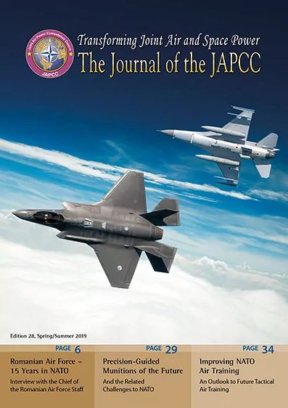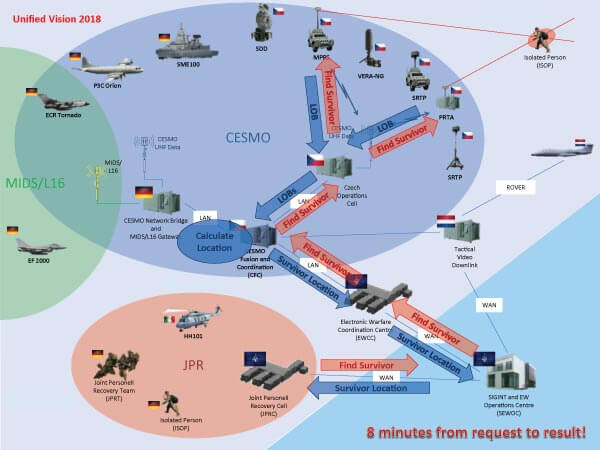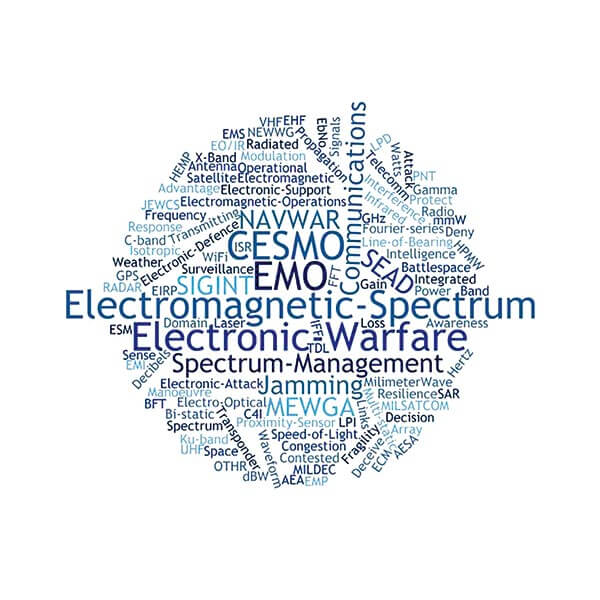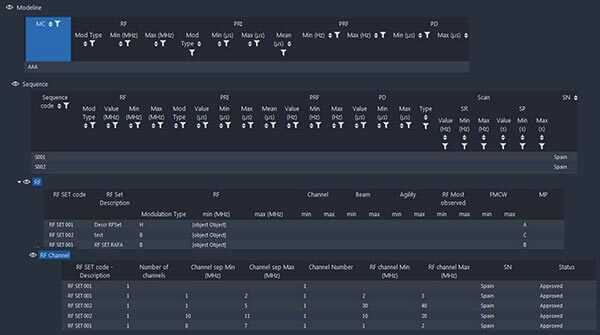New Functional Services are on Their Way to Enhance NATO’s Ability to Effectively Command and Control Electromagnetic Operations.
Introduction
During a NATO-led operation, a helicopter crashed due to a malfunction. The helicopter crashed well within a contested area. Unfortunately, the pilot was not able to transmit his last position prior to the crash. This event changed the daily routine within the NATO Combined Joint Task Force ELBONIA staff who immediately initiated the contingency plans for personnel recovery in hostile-controlled areas. Without loss of time, the Commander reviewed the latest known geolocation of the helicopter and made the rescue of the downed crew his top priority.
All available assets and sensors were tasked to search for, identify and geo-locate the downed crew within the defined search area. The chief of the Electronic Warfare Coordination Cell (EWCC)1 tasked his available Electronic Warfare (EW) assets to focus on any electromagnetic emissions related to the crash by issuing an updated Emission of Interest (EOI) list. The updated EOI covered call sign, combat identification last recorded transmission (time/space) and emergency beacon search priorities. The radio frequencies for the downed pilot’s personal AN/PRC-1122 Survival Radio were uploaded via the Cooperative Electronic Support Measure Operations (CESMO)3 Fusion Cell (CFC). Instantaneously all CESMO equipped assets received the updated EOI to sense for the requested frequencies. The basic concept of CESMO is to increase NATO-led formations’ collective exploitation through the benefits of using multi-platform intercept data. The collected multi-platform intercept data is shared in near real-time and supports the need for rapid geo-location of targets/EOI from different locations (altitude and azimuth) and orientations. Near real-time sharing enables rapid and accurate geo-location and the ability to defeat threats in a matter of seconds. It also provides the ability to geo-locate and link up with allied forces who find themselves beyond the reach of established command systems.
Figure 1: EW reporting chain at Unified Vision 2018 for the personnel recovery event.
The sensor network available on the day of the crash consisted of two Tornados,4 a P3C Orion5 and some ground-based surveillance vehicles. Eight minutes after the crash the Chief of EWCC reported the triangulated position of the AN/PRC-112 to the operations centre. Immediately thereafter an available aircraft with video downlink capability was tasked to investigate the signal and verify the position. The helicopter and crew were found, and the rescue mission could proceed.
This scenario took place during NATOs Joint Intelligence, Surveillance and Reconnaissance (ISR) Trial Unified Vision 2018. The eight minutes from the initial incident to the successful localization and identification of the crashed crew could be rated as a great achievement. However, it should be noted that the software, tools and systems used in the EWCC to coordinate the search in the spectrum were not at all advanced or highly sophisticated. The NATO Emitter Database (NEDB)6, as a reference database, still runs its queries within a Microsoft® Access Database and the CFC was not connected with the rest of the NATO Trial Network. Information was manually moved between the different systems to overcome the lack of connectivity and interoperability. The current processing, including manual movement of information, requires additional staffing. This example highlights NATO’s need for new tools and functional services to ensure proper Command and Control (C2) of Electromagnetic Operations (EMO). Command and Control (C2) of EW is designed to provide this.
Figure 2: C2 of EW related word cloud.
Electromagnetic Operations
NATO forces are required to operate within an increasingly complex Electromagnetic Environment (EME)7, which is defined as an operating environment8 by NATO. Commanders are tasked to attain the level of superiority required to enable effective friendly forces’ use of the EME while simultaneously exploiting, preventing or reducing the adversary forces’ EME usage. EMO consists not only of EW but several other disciplines which operate in the EME, such as navigation warfare, spectrum management, and signal intelligence. As EW has evolved from isolated operations in the EME at the tactical level towards joint EMO at the strategic and operational level, EW remains the combat discipline of EMO.
NATO doctrine recognizes that NATO operations are complicated by an increasingly congested and contested EME.9 All modern forces conduct operations that depend on the use of the EME. The recognized need for military forces to have access to and utilize the EME creates vulnerabilities and opportunities for EW. Today’s communication, sensing and guidance devices, whose function depends upon electromagnetic energy, are increasingly used both alone and in networked arrangements by civilian and military organizations.10
Command and Control of Electronic Warfare – A Project
EMO demands a level of coordination and synchronization which is impossible without specialized capabilities that support EME situational awareness, coordination and priority of actions.
Command and Control of Electronic Warfare (C2 of EW) describes the development and implementation activities associated with the supporting functional services.
The C2 of EW project will be implemented incrementally. The first increment will replace the legacy fielded NEDB as the foundational data provider for C2 of EW. The second increment should fulfil the Minimum Military Requirements (MMR) for planning, coordinating and managing EW activities focused on mission execution. Future increments, including support to EW, integration for threat assessment, planning and coordination of force employment, operational reporting, Navigation Warfare and Spectrum Management related tools will follow as well as cueing to/from other functional services. An agile acquisition approach to C2 of EW should ensure the timely fulfilment of the highest prioritized requirements. This approach should also allow for added functionality as NATO EMO evolves.
An information exchange requirements working group is currently reviewing and updating existing NATO EW messages to ensure their relevance and actuality. As a result, the NATO Common Electronic Order of Battle (C-EOB) exchange format will be introduced.
The C2 of EW supports NATO’s exploitation of the EME from stabilization or humanitarian operations through to major combat operations, ranging in scope from a single radio-controlled improvised-explosive device incident to operations against sophisticated Integrated Air Defence Systems (IADS). C2 of EW is by design intended to enhance the knowledge of the EME and inform Commander’s decisions with the ultimate goal being to achieve EMS superiority.
NATO Emitter Database Next Generation
The NATO Emitter Database (NEDB) was established as a NATO database and information sharing tool on electromagnetic systems over 25 years ago. It is NATO’s primary platform for EW mutual support and exchange of the best emitter data available in both peacetime and periods of crisis. Therefore it is one of the most important sources of information to enable C2 of EW. Since its inception, the NEDB has been continuously expanded to facilitate the description of new electromagnetic systems and associated platforms.
Recent operational requirements and technological developments triggered a technology uplift of the NEDB into the NATO Emitter Database Next Generation (NEDB-NG). The existing database does not effectively address NATO’s emitter data management processes, network security policies and lacks automation and integration with other information capabilities. There is also a requirement for a more complex data model that can adequately describe the complex modern emitters which continue to proliferate within the electromagnetic environment.
The NEDB-NG will be delivered during the first increment of C2 of EW. It was developed as a web-based capability, with advanced data storage and near real-time data-sharing capabilities, which can be deployed in a federated infrastructure of a system of systems. All existing NEDB data will be migrated into NEDB-NG which will be available and run on the NATO Secret Wide Area Network. It will also be accessible through Battlefield Information Collection and Exploitation Systems (BICES) networks to all NATO nations. Each NATO nation may also have national instances of NEDB-NG running on their own National networks.
An innovative, agile methodology has been adopted for developing the NEDB-NG, and the user community is directly involved in the design and development process. The Initial Operational Capability (IOC) is planned to be delivered in 2019 with full service expected in 2020.
Figure 3: NEDB-NG Mock-up used to support the design of the Database Reader View. The image shows the filters available at the mode line level.
NATO Recognized Electromagnetic Picture
The NATO Recognised Electromagnetic Picture (REMP) aims to visualize EM activity in time and space (3D tracking) in a manner that is relevant to enhance situational awareness and the effective conduct of Allied EMO. NATO REMP seeks to compile all EOI for own, adversarial and neutral entities within the Joint Operations Area (JOA). The NATO REMP will utilize NATO Core Geographical Information Services (NATO Core GIS) to visualize geographically referenced EM information for dissemination and storage. As such it will provide a seamless sharing of the REMP into the NATO Common Operational Picture (NCOP), increasing the awareness of EMO across the Joint Force.
The NATO REMP will be a core function of NATO’s future C2 of EW and will support the full range of features required for NATO EMO including planning, directing, monitoring and assessment of the EMO. Key to the support of planning and assessment of Allied EMO is the monitoring of near real-time universal EM activities to direct own forces’ EM actions and capabilities in a congested and contested Electromagnetic Spectrum (EMS). Additionally, the NATO REMP will visualize the Electronic Order of Battle (EOB), showcasing the full EMS capability of platforms or force elements within the required area. The planning function of the NATO REMP will support the identified need for an agile approach to EMO. Modern military operations require constant refinement of own EMO. Own EMO will be planned and assessed through digitalized modelling and propagation of EM sequences for each operational phase and account for the relevant terrain. The NATO REMP will facilitate reduced Electromagnetic Interference (EMI) within the Joint Forces through a shared understanding between the EW and Spectrum Management communities.
The NATO REMP enables the visualization of the EME by bringing together NATO’s EMO capabilities in a unified and coherent way. It will support NATO’s wider EMO community of interest well beyond EW.
Conclusion
With C2 of EW functional services in place, the recovery scenario could continue up to the point of a successful extraction of the crew and recovery of critical materials like crypto and other technological advances which keep allied forces ahead of the adversary. The EWCC would provide an overview of threats and other activities in the EME for the overall mission planning and execution. Based on available data, EW sensors and self-protection equipment on the extracting assets could be updated to meet the current threats. This however also demands the near real-time collaboration with national EW reprogramming units. The joint restricted frequency list would be updated and prioritized to optimize the undisrupted Command, Control and Coordination of own forces. All completed with increased accuracy of information, speed and agility in the employment and integration of EMO.
The NATO EW community has developed a very mature set of criteria for C2 of EW based on an in-depth study of command and control in general and the C2 of EW specifically. The EW study includes a full review of NATO’s EW information flow, formatting and usability. With these functional services, NATO will have a clear picture of the EME in the operational area, enabling effective EMO as another layer in the achievement of mission objectives and enabling the protection of own forces.
The future EME will require an advanced understanding of EME enabling exploitation, offensive and defensive EMO. NATO will be prepared by ensuring that the EMO community and EW Operators have the right tools to achieve EME superiority.
‘EW has been a sleeping dragon, hidden away and forgotten for a generation. Now the awakened dragon needs to be controlled!’












